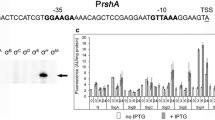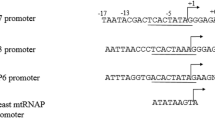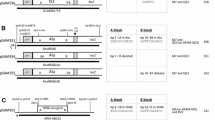Summary
We have determined the nucleotide sequence of twoBacillus subtilis promoters (veg andtms) that are utilized by the principal form ofB. subtilis RNA polymerase found in vegetative cells (σ55-RNA polymerase) and have compared our sequences to those of several previously reportedBacillus promoters. Hexanucleotide sequences centered approximately 35 (the “-35” region) and 10 (the “-10” region) base pairs upstream from theveg andtms transcription startpoints (and separated by 17 base pairs) corresponded closely to the consensus hexanucleotides (TTGACA and TATAAT) attributed toEscherichia coli promoters. Conformity to the preferred -35 and -10 sequences may not be sufficient to promote efficient utilization byB. subtilis RNA polymerase, however, since three promoters (veg, tms andE. coli tac) that conform to these sequences and that are utilized efficiently byE. coli RNA polymerase were used with highly varied efficiencies byB. subtilis RNA polymerase.
We have also analyzed mRNA sequences in DNA located downstream from eightB. subtilis chromosomal and phage promoters for nucleotide sequences that might signal the initiation of translation. In accordance with the rules of McLaughlin, Murray and Rabinowitz (1981), we observe mRNA nucleotide sequences with extensive complementarity to the 3′ terminal region ofB. subtilis 16S rRNA, followed by an initiation codon and an open reading frame.
Similar content being viewed by others
References
Achberger EC, Whiteley HR (1981) The role of the δ peptide of theBacillus subtilis RNA polymerase in promoter selection. J Biol Chem 256:7424–7432
Berkner KL, Folk WR (1977) Polynucleotide kinase exchange reaction: quantitative assay for restriction endonuclease-generated 5′-phosphoryl termini in DNAs. J Biol Chem 252:3176–3184
Cohen SN, Chang ACY, Boyer HW, Helling RB (1973) Construction of biologically functional bacterial plasmidsin vitro. Proc Natl Acad Sci USA 70:3240–3244
Donnelly CE, Sonenshein AL (1982) Genetic fusion ofEscherichia coli lac genes to aBacillus subtilis promoter. In: Ganeson A, Hoch J, Chang S (eds) Molecular cloning and gene regulation inBacilli. Academic Press, New York, in press
Donis-Keller H (1979) Site specific cleavage of RNA. Nucl Acids Res 7:179–192
Ehrlich SD (1978) DNA cloning inBacillus subtilis. Proc Natl Acad Sci USA 75:1433–1436
Haldenwang WG, Banner CDB, Ollington JF, Losick R, Hoch JA, O'Connor MB, Sonenshein AL (1980) Mapping a cloned gene under sporulation control by insertion of a drug-resistance marker into theBacillus subtilis chromosome. J Bacteriol 142:90–98
Haldenwang WG, Losick R (1980) A novel RNA polymerase sigma factor fromBacillus subtilis. Proc Natl Acad Sci USA 77:7000–7004
Hoffman DJ, Niyogi SK (1973) RNA initiation with dinucleoside monophosphates during transcription of bacteriophage T4 DNA with RNA polymerase ofEscherichia coli. Proc Natl Acad Sci USA 70:574–578
Kreft J, Bernhard K, Goebel W (1978) Recombinant plasmids capable of replication inB. subtilis andE. coli. Mol Gen Genet 162:59–67
Klenow H, Henningson I (1970) Selective elimination of the exonuclease activity of the deoxyribonucleic acid polymerase fromEscherichia coli B by limited proteolysis. Proc Natl Acad Sci USA 65:168–175
Kroyer J, Chang S (1981) The promoter-proximal region of theBacillus licheniformis penicillinase gene: Nucleotide sequence and predicted leader peptide sequence. Gene 15:343–347
Lee G, Hannett NM, Korman A, Pero J (1980) Transcription of cloned DNA fromBacillus subtilis phage SP01: requirement for hydroxymethyluracil-containing DNA by phage-modified RNA polymerase. J Mol Biol 139:407–422
Lee G, Pero J (1981) Conserved nucleotide sequences in temporally-controlled phage promoters. J Mol Biol 152:247–265
Lee G, Talkington C, Pero J (1980) Nucleotide sequences of a promoter recognized byBacillus subtilis RNA polymerase. Mol Gen Genet 180:57–65
Legault-Demare L, Chambliss GH (1975) Selective messenger translation ofBacillus subtilis ribosomes. Mol Gen Genet 142:277–287
Losick R, Pero J (1981) Cascades of sigma factors. Cell 25:582–584
Maxam AM, Gilbert W (1980) Sequencing end-labeled DNA with base specific chemical cleavages. Meth Enzymol 65:499–559
McLaughlin JR, Murray CL, Rabinowitz JC (1981) Unique features in the ribosome binding site sequence of the Gram-positiveStaphylococcus aureus β-lactamase gene. J Biol Chem 256:11283–11291
Minkley EG, Pribnow D (1973) Transcription of the early region of bacteriophage T7: selective initiation with dinucleotides. J Mol Biol 77:255–277
Moran CP Jr, Lang N, Banner CDB, Haldenwang WG, Losick R (1981) Promoter for a developmentally-regulated gene inBacillus subtilis. Cell 25:783–791
Moran CP Jr, Lang N, Losick R (1981) Nucleotide sequence of aBacillus subtilis promoter recognized byBacillus subtilis RNA polymerase containing σ37. Nucl Acids Res 9:5979–5990
Murray CL, Rabinowitz JC (1982) Nucleotide sequences of transcription and translation initiation regions inBacillus phage ϕ29 early genes. J Biol Chem 257:1053–1062
Neugebauer K, Sprengel R, Schiller H (1981) Penicillinase fromBacillus licheniformas: nucleotide sequence of the gene and implications for the biosynthesis of a secretory protein in a Grampositive bacterium. Nucl Acids Res 9:2577–2588
Ollington JF, Losick R (1981) A cloned gene that is turned on at an intermediate stage of spore formation inBacillus subtilis. J Bacteriol 147:443–451
Ollington JF, Haldenwang WG, Huynh TV, Losick R (1981) Developmentally-regulated transcription in a cloned segment of theBacillus subtilis chromosome. J Bacteriol 147:432–442
Palva I, Pettersson RF, Kalkkinen N, Lehtovaara P, Sarvas M, Soderlund H, Takkinen K, Kaariainen L (1981) Nucleotide sequence of the promoter and NH2-terminal signal peptide region of the α-amylase gene fromBacillus amyloliquefaciens. Gene 15:43–51
Pero J, Nelson J, Fox TD (1975) Highly asymmetric transcription by RNA polymerase containing phage-SP01-induced polypeptides and a new host protein. Proc Natl Acad Sci USA 72:1589–1593
Ratzkin B, Carbon J (1977) Functional expression of cloned yeast DNA inEscherichia coli. Proc Natl Acad Sci USA 74:487–491
Rosenberg M, Court D (1979) Regulatory sequences involved in the promotion and termination of transcription. Annu Rev Genet 13:319–353
Shorenstein RG, Losick R (1973) Comparative size and properties of the sigma subunits of RNA polymerase fromBacillus subtilis andEscherichia coli. J Biol Chem 248:6170–6173
Siebenlist U, Simpson RB, Gilbert W (1980)E. coli RNA polymerase interacts homologously with two different promoters. Cell 20:269–281
Stallcup MR, Rabinowitz JC (1973) Initiation of protein synthesisin vitro by a clostridial system. J Biol Chem 248:3209–3215; 3216–3219
Struhl K, Cameron JR, Davis RW (1976) Functional genetic expression of enkaryotic DNA inEscherichia coli. Proc Natl Acad Sci USA 73:1471–1475
Tinoco I, Borer PN, Dengler B, Levine MD, Uhlenbeck OC, Crothers DM, Gralla J (1973) Improved estimation of secondary structure in ribonucleic acids. Nature New Biol 246:40–41
Tjian R, Losick R, Pero J, Hinnebush A (1977) Pruification and comparative properties of the delta and sigma subunits of RNA polymerase fromBacillus subtilis. Eur Journal Biochem 74:149–154
Wiggs JL, Bush JW, Chamberlin MJ (1979) Utilization of promoter and terminator sites on bacteriophage T7 DNA by RNA polymerases from a variety of bacterial orders. Cell 16:97–109
Yago Y, McLellan T, Frez W, Clewell D (1978) Antimicrobial agents and chemotherapy 13:884–887
Author information
Authors and Affiliations
Additional information
Communicated by E. Bautz
Rights and permissions
About this article
Cite this article
Moran, C.P., Lang, N., LeGrice, S.F.J. et al. Nucleotide sequences that signal the initiation of transcription and translation inBacillus subtilis . Molec. Gen. Genet. 186, 339–346 (1982). https://doi.org/10.1007/BF00729452
Received:
Issue Date:
DOI: https://doi.org/10.1007/BF00729452




